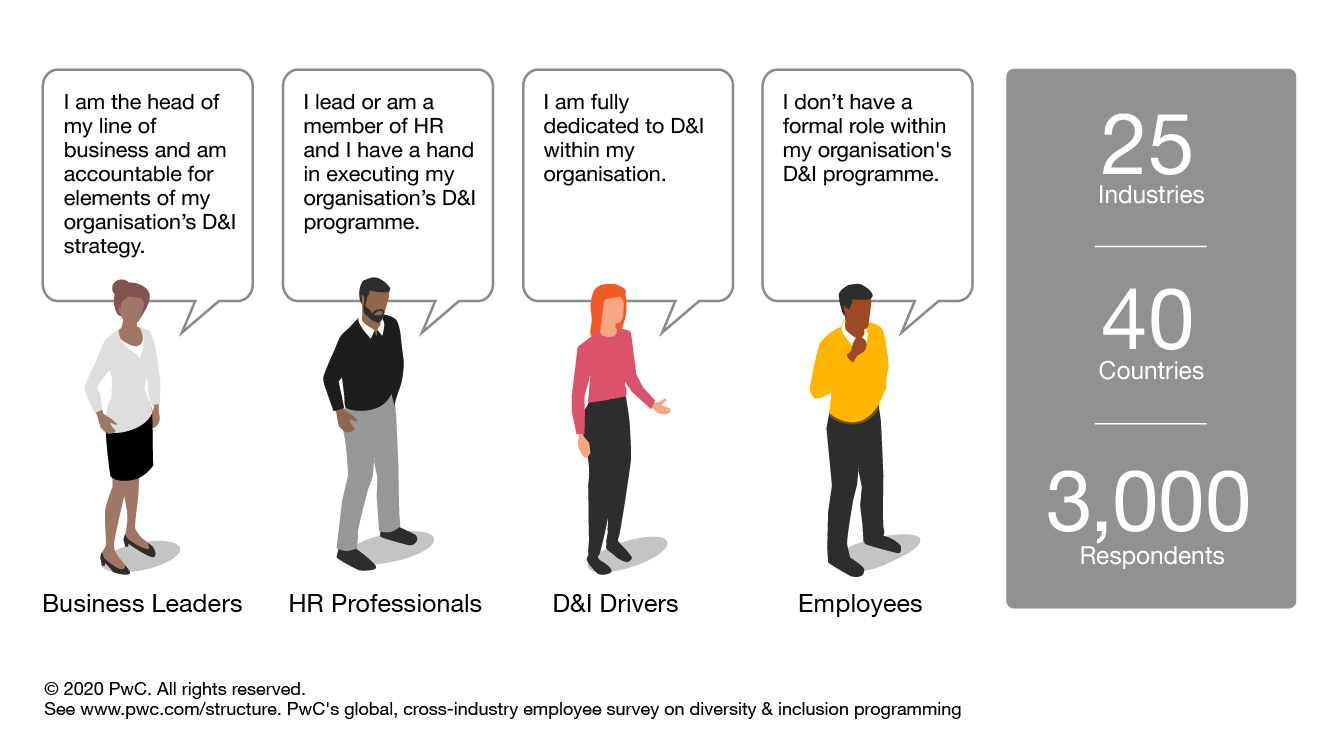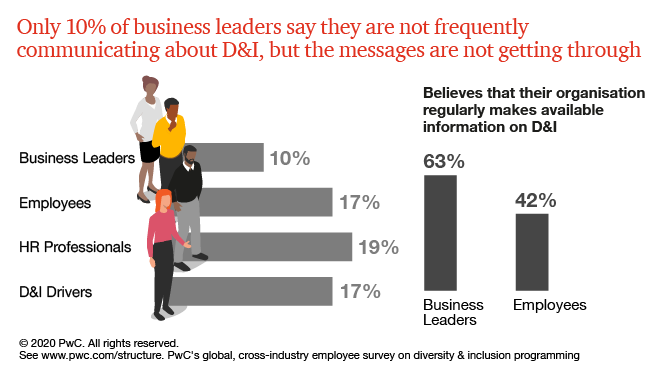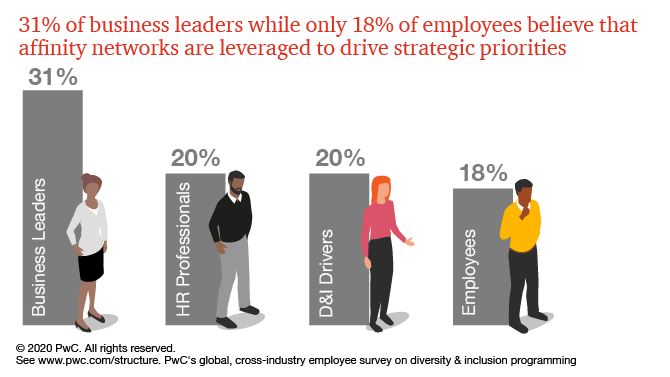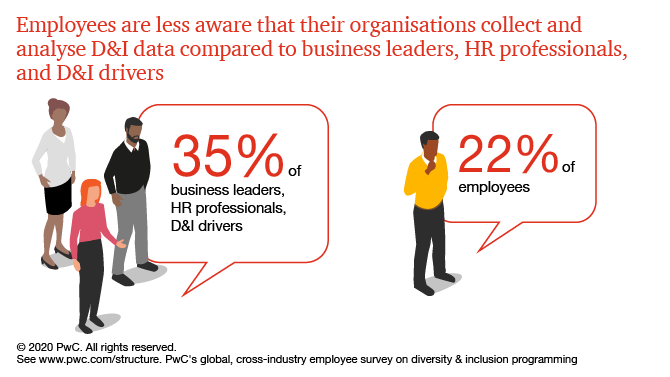
PwC’s multi-year, global, cross-industry survey explores what diversity & inclusion (D&I) programmes organisations have in place, and their impact on employee experience.
As employees, customers, and investors increasingly demand that the organisations they do business with model values of equity and inclusion, organisations are investing at unprecedented rates in D&I programmes, with 76% now saying it is a value or priority. In doing so, they hope to not only drive higher engagement with these stakeholders, but enhance financial performance and enable innovation.
Yet, despite this heightened commitment, organisations still have progress to make in designing and executing D&I programmes that meet these objectives, with a third of respondents indicating that they still view diversity as a barrier to progression at their organisations. Similarly, only 5% of organisations are succeeding in key dimensions of successful D&I programming. So what’s causing this disconnect?
One reason to account for this dissonance between what organisations are doing versus employee perception is that organisations are failing to empower their leaders on topics of D&I. Against our maturity model, 79% of leadership engagement on D&I remains at the basic or emerging levels. We also find that only 26% of organisations have D&I goals for leaders and only 17% have a C-Suite level diversity role in place while nearly 30% still have no D&I leader.
Continue reading to explore the results of the survey. Then, take the survey to diagnose the maturity of your organisation’s D&I programme, and see how your organisation compares to others in your region and industry. Survey responses will be recorded and aggregated with the overall survey benchmark results; individual responses will be kept strictly confidential.

What differentiates a leading D&I programme?
In our experience, the D&I programmes that are most effective at realising their goals are comprised of four key elements:
- Understanding the facts of today
- Building an inspirational strategy
- Developing leadership engagement
- Creating sustainable movement
Understanding the facts of today
Initiating a continuous process for understanding the facts of what’s happening inside the organisation today. Examples include:
- Gathering and analysing data to remove bias and increase opportunity, including demographic data, performance and compensation data, and feedback from customers.
- Sharing information on the diversity of the company with employees
Who we heard from


Business leaders believe they’re communicating about D&I, but the messages aren’t getting through.
While only a small percentage of business leaders (10%) believe they are not communicating to employees frequently about D&I, employees (17%), HR professionals (19%) and D&I drivers (17%) are nearly twice as likely to believe this is true. Similarly, 63% of business leaders - compared to 42% of employees - believe that their organisation regularly makes information available on the diversity of employees and leadership teams.
Leaders view affinity networks as strategic; employees disagree
Affinity groups have long been considered a foundational element of D&I programmes. While most serve as a source of connectivity and mentorship for employees, those that are most impactful are also leveraged to drive the strategic priorities of their organisations. While almost a third (31%) of business leaders believe their organisations leverage affinity groups in this way, roughly 20% of D&I drivers and HR professionals say the same. Most poignantly, that number is lower again (18%) for employees (who are the target participants for affinity groups).


Employees are unaware of efforts underway to drive a more inclusive culture
Gathering and analysing data on discrepancies in compensation, hiring, performance and promotion is one of the most powerful ways in which organisations can tackle the unconscious biases that undermine an inclusive culture. The majority of respondents (about two-thirds based on survey data) indicated their organisations have not yet adopted this practice. However, even among those that do, employees are less likely to be aware of these efforts. Survey data shows that business leaders, D&I drivers, and HR professionals, who are likely closely involved in using data in this way, are all nearly equally likely to say that their organisations gather and analyse compensation and performance data by different dimensions of diversity (roughly 35%). However, employees, who are less likely to participate in these processes, are much less likely (roughly 22%) to say these efforts exist at their organisations.
Moving forward: Getting your organisation on the same page when it comes to your D&I agenda
Business leaders - who may be supportive of D&I efforts but are further removed from the day-to-day programme activity - may have misconceptions about what’s actually in place in their organisations. As organisations all have subcultures, business leaders may also not be as attuned to behaviors ‘on the ground’ that are causing employees to feel that their environment is not inclusive. On the other hand, employees may not be aware of good work that is happening (e.g. data collection across different dimensions of diversity). Both misconceptions need to be corrected to have authentic leadership support and employee engagement in D&I.
So what can you do to make sure you’re getting the most out of your D&I investments and effectively engaging all personas in building a more inclusive culture? Start with asking yourself some of the key questions below:
- Am I getting leaders the right information on D&I data and programming (e.g. demographic data, retention, updates on D&I programmes and goals)?
- Am I using data to monitor the effectiveness of D&I investments so that I can understand current gaps and opportunities for my D&I programmes?
- Am I leveraging affinity groups effectively? Have I assigned them an executive level sponsor, allocated funding, and/or given them a role in driving strategic business decisions?
- Have I adequately listened to a range of employee perspectives to inform my D&I roadmap?
- Is there a compelling narrative around my organisation’s D&I story?
- Has D&I been integrated into all aspects of my organisation (e.g. hiring, performance and development, and supply chain)?
- During reorganisation or restructuring, does my organisation go beyond looking for possible adverse impacts to consider the potential future impacts on diversity?
Download data sheets
Explore the data sheets below to view the results of the survey by region or industry


